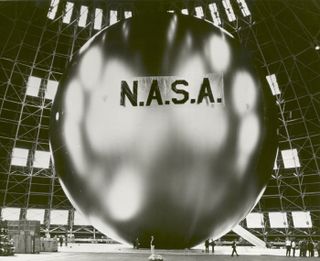NASA names moon mountain after Black mathematician and 'Hidden Figure' Melba Mouton
Melba Mouton worked during the era of "Hidden Figures" at NASA. The newly named Mons Mouton overlooks an area that will also be targeted by an ice-hunting rover in 2024 or so.
NASA named a huge moon landmark after a prominent Black mathematician who worked during at the agency the "Hidden Figures" era.
The name of Melba Mouton (1929–1990) will be designated by NASA on a Delaware-size flat moon mountain near the water-rich lunar south pole. The moon's south pole is a target of Artemis program astronauts, who are expected to land as soon as 2025.
The mountain is one of 13 candidate landing sites for Artemis 3, and is adjacent to where the agency's ice-hunting VIPER (Volatiles Investigating Polar Exploration Rover) lunar rover will touch down in 2024 or so upon Astrobotic's Griffin lunar lander. It was the VIPER team who proposed Mons Mouton's name, NASA officials stated Wednesday (Feb. 15).
"Mons Mouton" (MOO-tawn) has also been proposed to the International Astronomical Union that serves as the official designator of space landmarks around the world. Mouton "charted a path for other women and people of color to pursue careers and lead cutting-edge science at NASA," Sandra Connelly, the agency's acting associate administrator for science, said in the statement.
Related: NASA's real 'Hidden Figures'

The announcement was made during Black History Month, which runs for the month of February. The naming also serves as a crucial reminder of the "Hidden Figures," or Black female mathematicians and engineers, who played key background roles at NASA for decades before being publicized in a bestselling book (and Hollywood movie) that were both released in 2016.
Mouton joined NASA in 1959 at the Goddard Space Flight Center near Baltimore. Segregation and discrimination against African-Americans were prevalent at this time, following centuries of enslavement, lynchings and institutional prejudice. It was only in 1954 that the Supreme Court ruled segregation of public schools unconstitutional in Brown v. Board of Education, for example.
Get the Space.com Newsletter
Breaking space news, the latest updates on rocket launches, skywatching events and more!
Many Black individuals worked in the background amid this difficult environment, and NASA has been working to highlight their contributions in the past decade as the Black community still faces numerous institutional and societal barriers today. One of NASA's biggest nods came with naming the agency's headquarters after Black mathematician Katherine Johnson in 2020. NASA has also committed to landing people of color on the moon.

Shortly after Mouton joined NASA, she became the head mathematician of the "human computers" who tracked the early communications satellites, Echo 1 and Echo 2, that reached Earth's orbit in 1960 and 1964. Mouton then progressed to head programmer in 1961, leading a team responsible for tracking spacecraft locations and trajectories.

Mouton's retirement in 1973 came after she was appointed to assistant chief of research programs for the trajectory and geodynamics division at Goddard. She also received an Apollo Achievement Award after the successful Apollo 11 debut human moon landing of July 20, 1969.
The mountain that holds Mouton's name is roughly as tall as the 20,310-foot (6,190-meter) Denali, the highest mountain in North America, NASA said in the statement. The surface appears relatively old and unmarked by craters, making this plateau a potential zone to learn about the moon's very early history.
VIPER, built by Astrobotic for NASA, is one of the agency's Commercial Lunar Payload Services program recipients. CLPS aims to deliver a suite of scientific robots and payloads to the moon's surface to support the Artemis missions.
Elizabeth Howell is the co-author of "Why Am I Taller?" (ECW Press, 2022; with Canadian astronaut Dave Williams), a book about space medicine. Follow her on Twitter @howellspace. Follow us on Twitter @Spacedotcom or Facebook.
Join our Space Forums to keep talking space on the latest missions, night sky and more! And if you have a news tip, correction or comment, let us know at: community@space.com.

Elizabeth Howell (she/her), Ph.D., was a staff writer in the spaceflight channel between 2022 and 2024 specializing in Canadian space news. She was contributing writer for Space.com for 10 years from 2012 to 2024. Elizabeth's reporting includes multiple exclusives with the White House, leading world coverage about a lost-and-found space tomato on the International Space Station, witnessing five human spaceflight launches on two continents, flying parabolic, working inside a spacesuit, and participating in a simulated Mars mission. Her latest book, "Why Am I Taller?" (ECW Press, 2022) is co-written with astronaut Dave Williams.